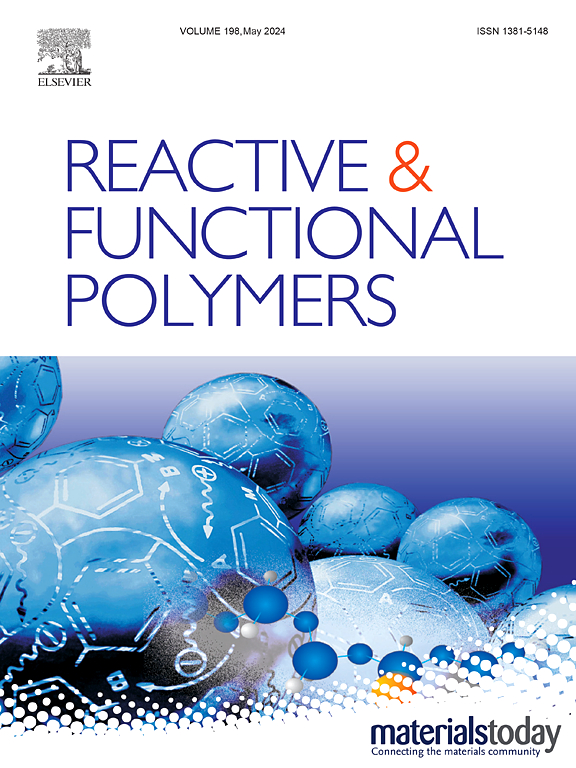ph响应明胶/琼脂糖/镁掺杂碳量子点水凝胶纳米复合材料靶向姜黄素递送脑癌治疗
IF 5.1
3区 工程技术
Q1 CHEMISTRY, APPLIED
引用次数: 0
摘要
本研究探讨了一种ph敏感纳米载体的配方和特性,用于姜黄素(Cur)的靶向和控制释放治疗脑癌。该纳米载体由明胶(G)、琼脂糖(Aga)和镁掺杂碳量子点(Mg-CQD)组成,采用水包油/水包油(w/o/w)双乳化法制备。这些材料表现出pH响应性、生物相容性和生物降解性,这对于解决Cur的局限性至关重要,包括溶解度不足和快速代谢。对U-87 MG胶质瘤细胞的体外细胞毒性试验显示,细胞活力降低了49%,而对L929成纤维细胞的毒性最小,表明有选择性抗癌潜力。该纳米载体在酸性条件下具有调控和缓释功能,包封效率为45.75%,载药效率为85.5%,提高了其生物利用度和治疗效果。表征证实纳米颗粒分布均匀(平均尺寸:193.5 nm;zeta电位:−42 mV),药物包封成功。FTIR、XRD、FE-SEM等测试验证了药物包封效果好、纳米颗粒分布均匀、稳定性好。这些发现强调了纳米载体在靶向癌症治疗方面的潜力,它提供了治疗效果和安全性,在纳米医学中有着有趣的应用。本文章由计算机程序翻译,如有差异,请以英文原文为准。

pH-responsive Gelatin/Agarose/Magnesium-doped carbon quantum dot hydrogel nanocomposite for targeted curcumin delivery in brain cancer therapy
This research examines the formulation and characterization of a pH-sensitive nanocarrier for the targeted and controlled release of curcumin (Cur) in the treatment of brain cancer. The nanocarrier consists of gelatin (G), agarose (Aga), and magnesium-doped carbon quantum dots (Mg-CQD), produced by a water-in-oil-in-water (w/o/w) double emulsification method. These materials demonstrate pH responsiveness, biocompatibility, and biodegradability, crucial for addressing Cur's limitations, including inadequate solubility and fast metabolism. In vitro cytotoxicity assays on U-87 MG glioma cells showed a 49 % reduction in cell viability, whereas minimal toxicity was observed in L929 fibroblast cells, indicating selective anticancer potential. The nanocarrier exhibited a regulated and extended release of Cur under acidic conditions, achieving encapsulation and loading efficiencies of 45.75 % and 85.5 %, respectively, hence enhancing its bioavailability and therapeutic efficacy. Characterization confirmed uniform nanoparticle distribution (average size: 193.5 nm; zeta potential: −42 mV) and successful drug encapsulation. FTIR, XRD and FE-SEM tests validated the effective drug encapsulation, uniform distribution of nanoparticles, and stability. The findings underscore the nanocarrier's potential for targeted cancer therapy, providing both therapeutic efficacy and safety, with intriguing applications in nanomedicine.
求助全文
通过发布文献求助,成功后即可免费获取论文全文。
去求助
来源期刊

Reactive & Functional Polymers
工程技术-高分子科学
CiteScore
8.90
自引率
5.90%
发文量
259
审稿时长
27 days
期刊介绍:
Reactive & Functional Polymers provides a forum to disseminate original ideas, concepts and developments in the science and technology of polymers with functional groups, which impart specific chemical reactivity or physical, chemical, structural, biological, and pharmacological functionality. The scope covers organic polymers, acting for instance as reagents, catalysts, templates, ion-exchangers, selective sorbents, chelating or antimicrobial agents, drug carriers, sensors, membranes, and hydrogels. This also includes reactive cross-linkable prepolymers and high-performance thermosetting polymers, natural or degradable polymers, conducting polymers, and porous polymers.
Original research articles must contain thorough molecular and material characterization data on synthesis of the above polymers in combination with their applications. Applications include but are not limited to catalysis, water or effluent treatment, separations and recovery, electronics and information storage, energy conversion, encapsulation, or adhesion.
 求助内容:
求助内容: 应助结果提醒方式:
应助结果提醒方式:


